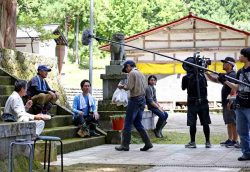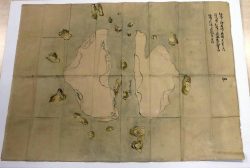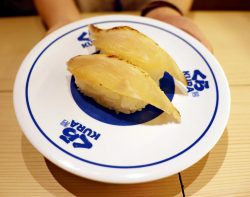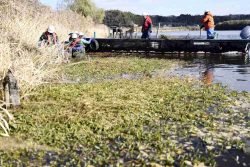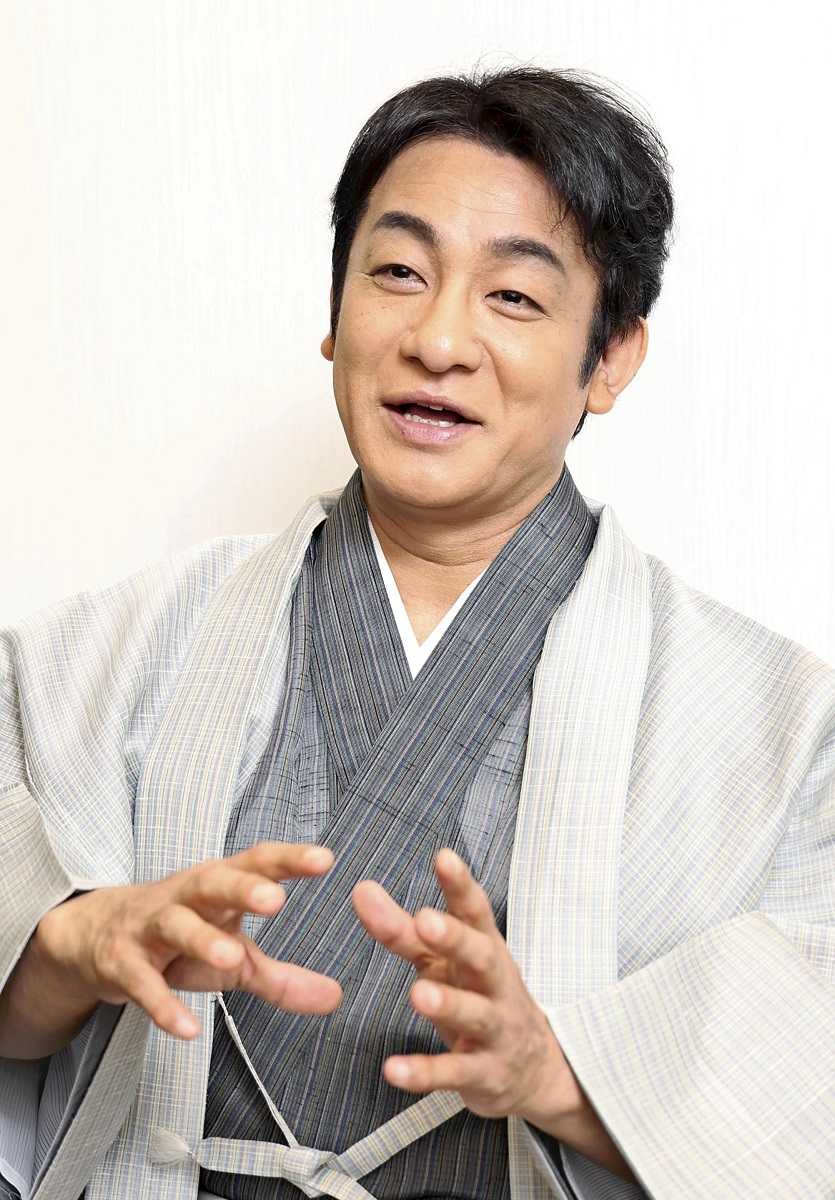
Kataoka Ainosuke speaks during an interview with The Japan News in Tokyo on June 28.
6:00 JST, August 3, 2024
A brand new kabuki play based on the globally popular anime “Lupin III,” which was first performed in Tokyo in December last year, will be simultaneously live streamed in Japan and abroad on Aug. 11. In an interview with The Japan News, Kataoka Ainosuke, who plays the protagonist, emphatically expressed his confidence in the play: “I don’t mean to brag, but this work will not betray the expectations of those who love Lupin,” he said.
The new kabuki production “Lupin III” is an original story set in the Azuchi-Momoyama period (1568-1600) in which the Lupin gang battles bandits over a treasure. The main characters from the original anime produced by mangaka Monkey Punch appear in the production, with Ainosuke playing the lead role of Lupin. Ainosuke, who is himself a big fan of the original anime, recalls that he was initially “very happy, of course” when permission was given to turn “Lupin III” into a kabuki play, even as he thought that doing so would be “impossible.”
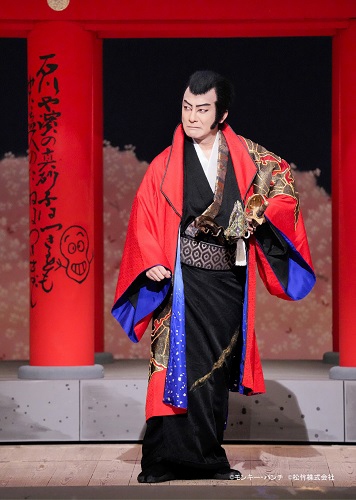
A scene from “Lupin III,” starring Kataoka Ainosuke
During discussions with the director, co-stars and others, he began to formulate an image of what it would look like “if Lupin were in the world of kabuki,” but he struggled to progress from that point. So he started by designing a poster.
The red jacket that Lupin often wears in the anime series was incorporated in the form of a red haori-like traditional Japanese costume. For Inspector Zenigata, who chases after Lupin, they created a costume that evoked the trench coat and hat he wears in the original anime.
Femme fatale character Fujiko Mine was dressed in a glittering costume inspired by oiran, high-class courtesans who appear in many kabuki works. Ainosuke recalls, “We had to create a poster that would make people think ‘that looks interesting!’”
Trying to produce a spectacular show on a limited budget, he had to think hard about the stage set. Originally, the director had his own ideas, but Ainosuke asked that there be a waterfall, a common feature in kabuki productions.
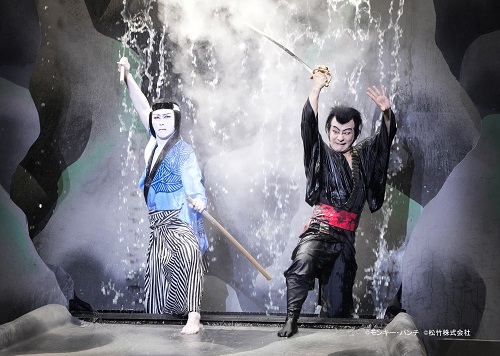
A scene from the new kabuki “Lupin III”
“I knew it was an inconvenient request, but if we gave up on it, our new work would be boring. I was very particular about it,” he said.
Rather than leaving all the work to the director, Ainosuke and the other performers worked together to create the features that would become the highlights of the show.
The climax of the new kabuki piece was inspired by a famous scene in the kabuki masterpiece “Benten Musume Meo no Shiranami” (“The Five Thieves”), in which all the main characters gather beside a river. Ainosuke emphasized that although it was a new kabuki production, “it will be enjoyable for both newcomers and regular kabuki audiences.”
He also put a lot of effort into the music for this production. Ainosuke wanted the theme song from the original anime to be used in the play. But unlike the original, the play’s version will feature Japanese traditional instruments such as shamisen and koto in the performance. “I hope you will enjoy the music as well,” he said with a smile.
Double the fun
With the easing of pandemic restrictions, kabuki theaters have been receiving more and more foreign visitors in their audiences, which Ainosuke called “very gratifying for us.” However, he also said, “It’s a bit sad to think that people from overseas may be more interested in kabuki than Japanese people.”
In addition to kabuki plays, Ainosuke has expanded his activities as an actor to include TV dramas and film productions. His performances in programs such as the drama “Hanzawa Naoki” have also been praised.
“The reason I appear not only in kabuki but also on film and TV is because I want to provide a point of entry to kabuki [for viewers],” said Ainosuke. This Lupin play was one such attempt to attract the attention of people who had never seen kabuki before.
“Some people say that such new kabuki productions are ‘not real kabuki,’ but classical kabuki is not the only kind of kabuki,” Ainosuke said. He pointed out that “Even Chikamatsu’s works were new works in his time,” referring to Chikamatsu Monzaemon, a famous playwright who was active in the Edo period (1603-1867).
Ainosuke hopes that the Lupin kabuki play will become a classic as time goes by and be restaged many times. “I always create new kabuki works in hopes that future generations will want to perform them,” he said.
When this production was staged last December, tickets sold out, and since that time there have been many requests to stream it overseas. Ainosuke says this made him feel that everyone was really attached to these characters.
Since the outbreak of the coronavirus, kabuki performances overseas have ceased. Ainosuke is enthusiastic about someday performing overseas, saying, “If there is an opportunity, I would love to do so.” He added that classical works are preferred in foreign countries, but “I think this would be an especially good one [for overseas audiences] because it lets them see both Lupin, who they already know, and kabuki, so it’s double the fun.”
Born in March 1972 in Sakai, Osaka Prefecture, Kataoka Ainosuke made his kabuki stage debut in 1981. He became the adopted son of kabuki actor Kataoka Hidetaro II, taking the name Kataoka Ainosuke VI, in 1992.
"JN Specialities" POPULAR ARTICLE
-

Disaster Preparedness / Apartment Management Associations: Instructions on What to Do in the Event of Power Outage
-

The Japan News / Weekly Edition (1/9-1/15)
-

Kawasaki Releases Guide to Sheltering at Home During Disasters, with Essential Tips for Apartment Residents
-

The Japan News / Weekly Edition (1/16-1/22)
-

The Japan News / Weekly Edition (12/26-1/1)
JN ACCESS RANKING
-

Japan Govt Adopts Measures to Curb Mega Solar Power Plant Projects Amid Environmental Concerns
-

Core Inflation in Tokyo Slows in December but Stays above BOJ Target
-

Tokyo Zoo Wolf Believed to Have Used Vegetation Growing on Wall to Climb, Escape; Animal Living Happily after Recapture
-

Univ. in Japan, Tokyo-Based Startup to Develop Satellite for Disaster Prevention Measures, Bears
-

JAL, ANA Cancel Flights During 3-day Holiday Weekend due to Blizzard





